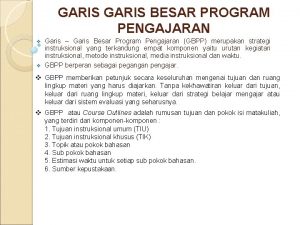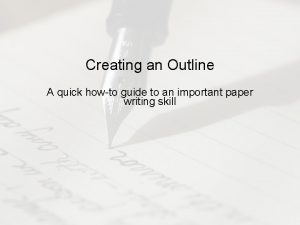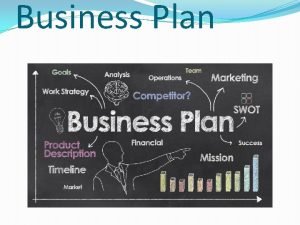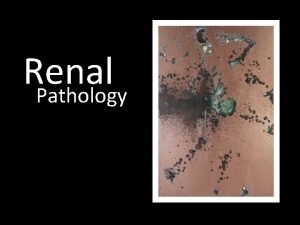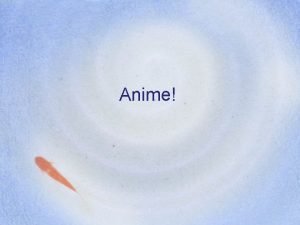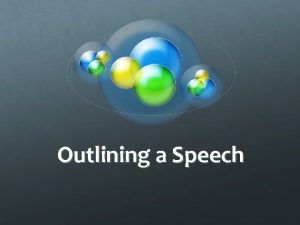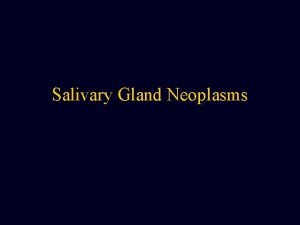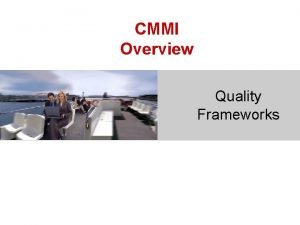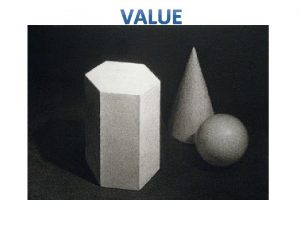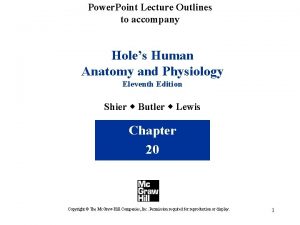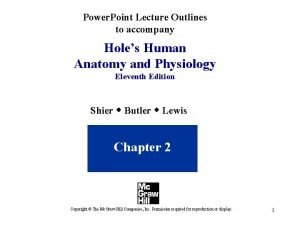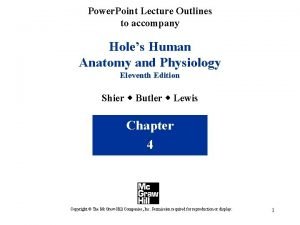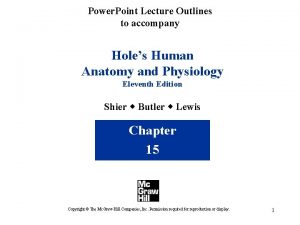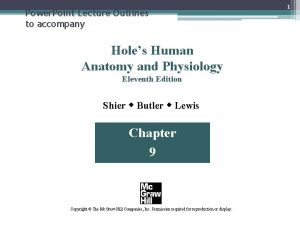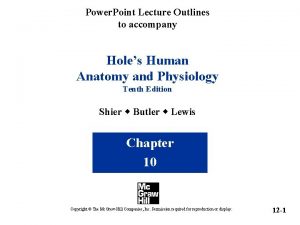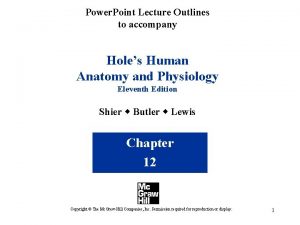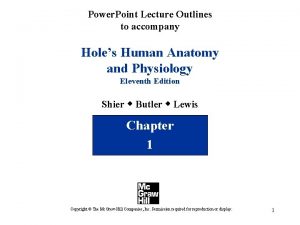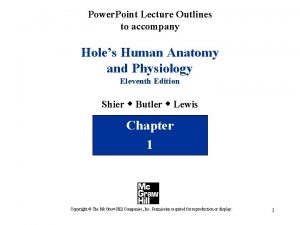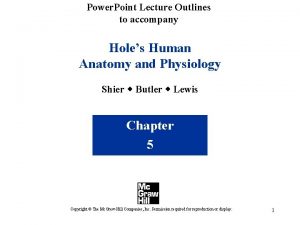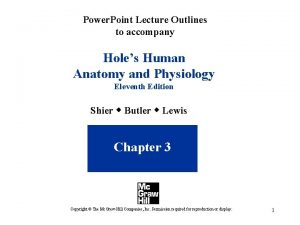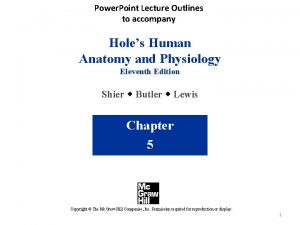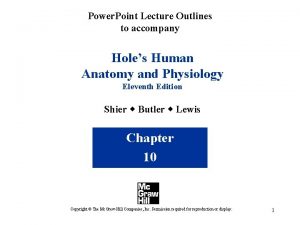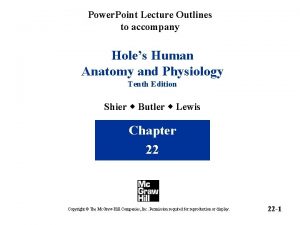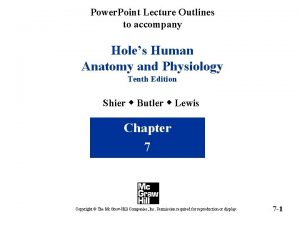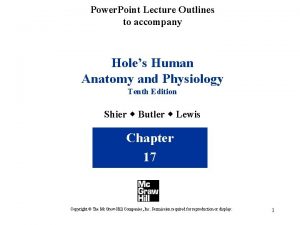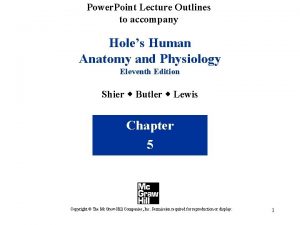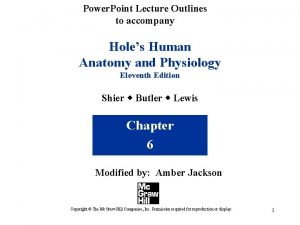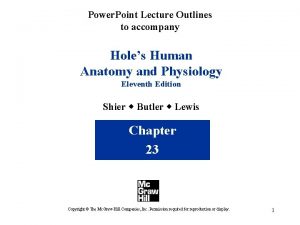Power Point Lecture Outlines to accompany Holes Human






























- Slides: 30

Power. Point Lecture Outlines to accompany Hole’s Human Anatomy and Physiology Tenth Edition Shier w Butler w Lewis Chapter 7 Copyright © The Mc. Graw-Hill Companies, Inc. Permission required for reproduction or display. 7 -1

Chapter 7 Skeletal System Bone Classification • Long Bones • Short Bones • Flat Bones • Irregular Bones • Sesamoid Bones 7 -2

Bone shape

Parts of a Long Bone • epiphysis • distal • proximal • diaphysis • compact bone • spongy bone • articular cartilage • periosteum • endosteum • medullary cavity • trabeculae • marrow • red • yellow 7 -3

Compact and Spongy Bone 7 -4

Microscopic Structure of Compact Bone • osteon • central canal • perforating canal • osteocyte • lacuna • bone matrix • canaliculus 7 -5

Bone Development Intramembranous Ossification • bones originate within sheetlike layers of connective tissues • broad, flat bones • skull bones (except mandible) • intramembranous bones Endochondral Ossification • bones begin as hyaline cartilage • most bones of the skeleton • endochondral bones 7 -6

Intramembranous ossification

Intramembranous Osteogenesis/Development • Mesenchyme( embryonic connective tissue), appear in the sites of future bones, differentiate into osteoblasts( bone forming cells). These cells deposit bony matrix and are surrounded by extra cellular matrix( ECM)( this matrix later will give rise to canaliculi). Osteoblasts will be located in lacunae which are now called osteocytes ( bone cells). • Blood vessels will surround bony matrix. Spongy bones forms in different directions along with blood vessels.



Endochondral Ossification • hyaline cartilage model • epiphyseal plate • primary ossification center • osteoblasts vs. osteoclasts • secondary ossification centers 7 -7


Growth at the Epiphyseal Plate First layer of cells Zone of resting cartilage • closest to the end of epiphysis • resting cells • anchors epiphyseal plate to epiphysis Second layer of cells Zone of proliferating cartilage • many rows of young cells • undergoing mitosis 7 -8

Growth at the Epiphyseal Plate Third layer of cells Zone of hypertrophic cartilage • older cells • left behind when new cells appear • cells enlarging and thickening the epiphyseal plate, starting to becoming calcified Fourth layer of cells Zone of calcified cartilage • thin • dead cells • calcified intercellular substance 7 -9


Homeostasis of Bone Tissue • Bone Resorption – action of osteoclasts and parathyroid hormone • Bone Deposition – action of osteoblasts and calcitonin 7 -10

Factors Affecting Bone Development, Growth, and Repair • Deficiency of Vitamin A – retards bone development • Deficiency of Vitamin C – results in fragile bones • Deficiency of Vitamin D – rickets, osteomalacia • Insufficient Growth Hormone – dwarfism • Excessive Growth Hormone – gigantism, acromegaly • Insufficient Thyroid Hormone – delays bone growth • Sex Hormones – promote bone formation; stimulate ossification of epiphyseal plates • Physical Stress – stimulates bone growth 7 -11

Vitamin D

Vitamin D formation

Role of hormones

Role of hormones

Bone Function • Support and Protection • gives shape to head, etc. • supports body’s weight • protects lungs, etc. • Body Movement • interacts with muscles • bones act as rigid bar of a lever • Blood Cell Formation • hematopoiesis • red marrow • Inorganic Salt Storage • calcium • phosphate • magnesium • sodium • potassium 7 -12

Skeletal Organization Axial Skeleton • head • neck • trunk Appendicular Skeleton • upper limbs • lower limbs • pectoral girdle • pelvic girdle 7 -15

Skeletal Organization 7 -16

Infantile Skull Fontanels – fibrous membranes 7 -30

Vertebral Column • cervical vertebrae (7) • thoracic vertebrae (12) • lumbar vertebrae (5) • sacrum • coccyx 7 -31

Life-Span Changes • decrease in height at about age 30 • calcium levels fall • bones become brittle • osteoclasts outnumber osteoblasts • spongy bone weakens before compact bone • bone loss rapid in menopausal women • hip fractures common • vertebral compression fractures common 7 -61

The diagram shows the negative feedback mechanism with the involvement of thyroid and parathyroid glands.

 Things that belong to salvation
Things that belong to salvation Accompany chapter 1
Accompany chapter 1 Lymphatic drainage of upper limb
Lymphatic drainage of upper limb Inkjet printers are considered legacy technology
Inkjet printers are considered legacy technology Holes essential of human anatomy and physiology
Holes essential of human anatomy and physiology 01:640:244 lecture notes - lecture 15: plat, idah, farad
01:640:244 lecture notes - lecture 15: plat, idah, farad Real power and reactive power
Real power and reactive power Power bi training powerpoint
Power bi training powerpoint Point point power
Point point power What is an outline ?
What is an outline ? Outline learning objectives
Outline learning objectives Kairos talk outlines
Kairos talk outlines Commercial law outline
Commercial law outline Four main components for effective outlines
Four main components for effective outlines A business plan is a document that outlines
A business plan is a document that outlines Pyelonephritis
Pyelonephritis 2 kings 4 8 17
2 kings 4 8 17 Outline anime
Outline anime Two types of outlines
Two types of outlines A haunted house by virginia woolf characters
A haunted house by virginia woolf characters Ksf outlines
Ksf outlines Mucoepidermoid carcinoma histology
Mucoepidermoid carcinoma histology Cmmi model outlines
Cmmi model outlines Outline of the book of acts
Outline of the book of acts Exegetical outline
Exegetical outline Ncic restricted files
Ncic restricted files Mun position paper outline
Mun position paper outline Visible outlines
Visible outlines Focal crypt abscess
Focal crypt abscess Disaster management in libraries and information centres
Disaster management in libraries and information centres Power system dynamics and stability lecture notes
Power system dynamics and stability lecture notes










